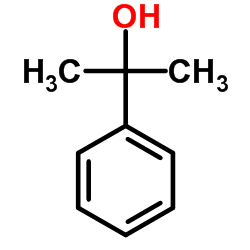α-Cumyl alcohol

α-Cumyl alcohol structure
|
Common Name | α-Cumyl alcohol | ||
|---|---|---|---|---|
| CAS Number | 617-94-7 | Molecular Weight | 136.19 | |
| Density | 1.0±0.1 g/cm3 | Boiling Point | 202.0±0.0 °C at 760 mmHg | |
| Molecular Formula | C9H12O | Melting Point | 28-32 °C(lit.) | |
| MSDS | Chinese USA | Flash Point | 87.8±0.0 °C | |
| Symbol |

GHS07 |
Signal Word | Warning | |
|
Development and application of a non-targeted extraction method for the analysis of migrating compounds from plastic baby bottles by GC-MS.
Food Addit. Contam. Part A. Chem. Anal. Control. Expo. Risk Assess. 31(12) , 2090-102, (2014) In 2011, the European Union prohibited the production of polycarbonate (PC) baby bottles due to the toxic effects of the PC monomer bisphenol-A. Therefore, baby bottles made of alternative materials, e.g. polypropylene (PP) or polyethersulphone (PES), are cur... |
|
|
[Information from the Soviet Toxicology Center].
Gig. Tr. Prof. Zabol. (8) , 53-6, (1982)
|
|
|
[Cleavage of 2-phenylpropan-1-ol and 2-phenylpropan-2-ol-glucuronide, 2 metabolites of isopropylbenzol (Cumol)].
Z. Rechtsmed. 97(2) , 83-8, (1986) The behaviour of 2-phenyl-1-propanol (I) and 2-phenyl-2-propanol (II) and their glucuronides with HCl has been investigated. While I shows a high acidic constancy, II undergoes a partial conversion into 2-phenylpropane (III) which itself yields numerous produ... |
|
|
Disposition and metabolism of cumene in F344 rats and B6C3F1 mice.
Drug Metab. Dispos. 39(3) , 498-509, (2011) Cumene is a high-production volume chemical that has been shown to be a central nervous system depressant and has been implicated as a long-term exposure carcinogen in experimental animals. The absorption, distribution, metabolism, and excretion of [(14)C]cum... |
|
|
Solvent effects on the AIBN forced degradation of cumene: Implications for forced degradation practices.
J. Pharm. Sci. 98(3) , 959-69, (2009) Solvent effects on the AIBN and ACVA forced degradation of cumene are explored. The degradant formation rates of the three cumene oxidative degradants, cumene hydroperoxide, acetophenone, and 2-phenyl-2-propanol are reported. The relative abundance and ratios... |
|
|
[Photometric determination of dimethylphenylcarbinol in water].
Gig. Sanit. (1) , 71-2, (1982)
|
|
|
[Toxicological evaluation of the plasticizer PB-I].
Gig. Sanit. (4) , 50-2, (2000)
|
|
|
Fragrance material review on 2-phenyl-2-propanol.
Food Chem. Toxicol. 50 Suppl 2 , S130-3, (2012) A toxicologic and dermatologic review of 2-phenyl-2-propanol when used as a fragrance ingredient is presented. 2-Phenyl-2-propanol is a member of the fragrance structural group Aryl Alkyl Alcohols and is a tertiary alcohol. The AAAs are a structurally diverse... |
|
|
Role of THR501 Residue in Substrate Binding and Catalytic Activity of Cytochrome P4501A1
Arch. Biochem. Biophys. 389(1) , 31-40, (2001) A putative binding region for cumene hydroperoxide in the active site of cytochrome P4501A1 was identified using photoaffinity labeling. Thr501 was determined as the most likely site of modification by azidocumene used as the photoaffinity label (T. Cvrk and ... |